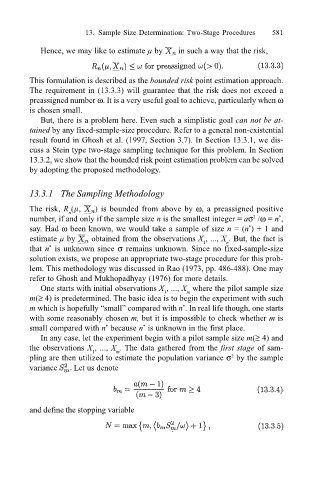Page 604 - Probability and Statistical Inference
P. 604
13. Sample Size Determination: Two-Stage Procedures 581
Hence, we may like to estimate µ by in such a way that the risk,
This formulation is described as the bounded risk point estimation approach.
The requirement in (13.3.3) will guarantee that the risk does not exceed a
preassigned number ω. It is a very useful goal to achieve, particularly when ω
is chosen small.
But, there is a problem here. Even such a simplistic goal can not be at-
tained by any fixed-sample-size procedure. Refer to a general non-existential
result found in Ghosh et al. (1997, Section 3.7). In Section 13.3.1, we dis-
cuss a Stein type two-stage sampling technique for this problem. In Section
13.3.2, we show that the bounded risk point estimation problem can be solved
by adopting the proposed methodology.
13.3.1 The Sampling Methodology
The risk, R (µ, ) is bounded from above by ω, a preassigned positive
n
number, if and only if the sample size n is the smallest integer = aσ /ω = n ,
2
*
*
say. Had ω been known, we would take a sample of size n = (n ) + 1 and
estimate µ by obtained from the observations X , ..., X . But, the fact is
1
n
*
that n is unknown since σ remains unknown. Since no fixed-sample-size
solution exists, we propose an appropriate two-stage procedure for this prob-
lem. This methodology was discussed in Rao (1973, pp. 486-488). One may
refer to Ghosh and Mukhopadhyay (1976) for more details.
One starts with initial observations X , ..., X where the pilot sample size
m
1
m(≥ 4) is predetermined. The basic idea is to begin the experiment with such
*
m which is hopefully small compared with n . In real life though, one starts
with some reasonably chosen m, but it is impossible to check whether m is
*
*
small compared with n because n is unknown in the first place.
In any case, let the experiment begin with a pilot sample size m(≥ 4) and
the observations X , ..., X . The data gathered from the first stage of sam-
1
m
pling are then utilized to estimate the population variance σ by the sample
2
variance Let us denote
and define the stopping variable

